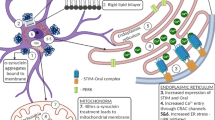Abstract
Multiple system atrophy (MSA) is a progressive neurodegenerative disease characterized by glial cytoplasmic inclusions containing insoluble α-synuclein. Since Ca2+ plays an important role in cell degeneration, [Ca2+] i in α-synuclein-overexpressed human glioma cells was analyzed by Fura-2 fluorometry. Overexpression of α-synuclein increased the basal level of [Ca2+] i , and a higher Ca2+ response to hydrogen peroxide was further observed. The effect that α-synuclein overexpression caused U251 cells to be more vulnerable to hydrogen peroxide was eliminated by Ca2+ chelator BAPTA-AM or transient receptor potential channels blocker SKF 96365 but not by L-type Ca2+ channel blocker nimodipine. These findings suggest that the dysregulation of cellular Ca2+ homeostasis caused by α-synuclein under oxidative stress may contribute to the glial cell death in MSA.





Similar content being viewed by others
References
Adamczyk A, Strosznajder JB (2006) Alpha-synuclein potentiates Ca2+ influx through voltage-dependent Ca2+ channels. Neuroreport 17(18):1883–1886
Brundin P, Karlsson J et al (2000) Improving the survival of grafted dopaminergic neurons: a review over current approaches. Cell Transplant 9(2):179–195
Cahoy JD, Emery B et al (2008) A transcriptome database for astrocytes, neurons, and oligodendrocytes: a new resource for understanding brain development and function. J Neurosci 28(1):264–278
Danzer KM, Haasen D et al (2007) Different species of alpha-synuclein oligomers induce calcium influx and seeding. J Neurosci 27(34):9220–9232
Droge W (2002) Free radicals in the physiological control of cell function. Physiol Rev 82(1):47–95
Fan MM, Raymond LA (2007) N-methyl-d-aspartate (NMDA) receptor function and excitotoxicity in Huntington’s disease. Prog Neurobiol 81(5–6):272–293
Fortin DL, Nemani VM et al (2005) Neural activity controls the synaptic accumulation of alpha-synuclein. J Neurosci 25(47):10913–10921
Furukawa K, Matsuzaki-Kobayashi M et al (2006) Plasma membrane ion permeability induced by mutant alpha-synuclein contributes to the degeneration of neural cells. J Neurochem 97(4):1071–1077
Galvin JE, Lee VM et al (2001) Synucleinopathies: clinical and pathological implications. Arch Neurol 58(2):186–190
Green KN, LaFerla FM (2008) Linking calcium to Abeta and Alzheimer’s disease. Neuron 59(2):190–194
Hettiarachchi NT, Parker A et al (2009) Alpha-Synuclein modulation of Ca2+ signaling in human neuroblastoma (SH-SY5Y) cells. J Neurochem 111(5):1192–1201
Jakes R, Spillantini MG et al (1994) Identification of two distinct synucleins from human brain. FEBS Lett 345(1):27–32
Larsen KE, Schmitz Y et al (2006) Alpha-synuclein overexpression in PC12 and chromaffin cells impairs catecholamine release by interfering with a late step in exocytosis. J Neurosci 26(46):11915–11922
Lee MK, Stirling W et al (2002) Human alpha-synuclein-harboring familial Parkinson’s disease-linked Ala-53 → Thr mutation causes neurodegenerative disease with alpha-synuclein aggregation in transgenic mice. Proc Natl Acad Sci USA 99(13):8968–8973
Mattson MP (2007) Calcium and neurodegeneration. Aging Cell 6(3):337–350
Mosharov EV, Larsen KE et al (2009) Interplay between cytosolic dopamine, calcium, and alpha-synuclein causes selective death of substantia nigra neurons. Neuron 62(2):218–229
Nemani VM, Lu W et al (2010) Increased expression of alpha-synuclein reduces neurotransmitter release by inhibiting synaptic vesicle reclustering after endocytosis. Neuron 65(1):66–79
Orrenius S, Zhivotovsky B et al (2003) Regulation of cell death: the calcium–apoptosis link. Nat Rev Mol Cell Biol 4(7):552–565
Papp MI, Kahn JE et al (1989) Glial cytoplasmic inclusions in the CNS of patients with multiple system atrophy (striatonigral degeneration, olivopontocerebellar atrophy and Shy–Drager syndrome). J Neurol Sci 94(1–3):79–100
Shults CW, Rockenstein E et al (2005) Neurological and neurodegenerative alterations in a transgenic mouse model expressing human alpha-synuclein under oligodendrocyte promoter: implications for multiple system atrophy. J Neurosci 25(46):10689–10699
Soper JH, Roy S et al (2008) Alpha-synuclein-induced aggregation of cytoplasmic vesicles in Saccharomyces cerevisiae. Mol Biol Cell 19(3):1093–1103
Specht CG, Tigaret CM et al (2005) Subcellular localisation of recombinant alpha- and gamma-synuclein. Mol Cell Neurosci 28(2):326–334
Stefanova N, Klimaschewski L et al (2001) Glial cell death induced by overexpression of alpha-synuclein. J Neurosci Res 65(5):432–438
Stefanova N, Reindl M et al (2005a) Oxidative stress in transgenic mice with oligodendroglial alpha-synuclein overexpression replicates the characteristic neuropathology of multiple system atrophy. Am J Pathol 166(3):869–876
Stefanova N, Reindl M et al (2005b) In vitro models of multiple system atrophy. Mov Disord 20(Suppl 12):S53–S56
Surmeier DJ (2007) Calcium, ageing, and neuronal vulnerability in Parkinson’s disease. Lancet Neurol 6(10):933–938
Tu PH, Galvin JE et al (1998) Glial cytoplasmic inclusions in white matter oligodendrocytes of multiple system atrophy brains contain insoluble alpha-synuclein. Ann Neurol 44(3):415–422
Volles MJ, Lansbury P T Jr (2003) Zeroing in on the pathogenic form of alpha-synuclein and its mechanism of neurotoxicity in Parkinson’s disease. Biochemistry 42(26):7871–7878
von Lewinski F, Keller BU (2005) Ca2+, mitochondria and selective motoneuron vulnerability: implications for ALS. Trends Neurosci 28(9):494–500
Wakabayashi K, Yoshimoto M et al (1998) Alpha-synuclein immunoreactivity in glial cytoplasmic inclusions in multiple system atrophy. Neurosci Lett 249(2–3):180–182
Wenning GK, Jellinger KA (2005) The role of alpha-synuclein in the pathogenesis of multiple system atrophy. Acta Neuropathol 109(2):129–140
Wenning GK, Stefanova N et al (2008) Multiple system atrophy: a primary oligodendrogliopathy. Ann Neurol 64(3):239–246
Yazawa I, Giasson BI et al (2005) Mouse model of multiple system atrophy alpha-synuclein expression in oligodendrocytes causes glial and neuronal degeneration. Neuron 45(6):847–859
Zhou W, Schaack J et al (2002) Overexpression of human alpha-synuclein causes dopamine neuron death in primary human mesencephalic culture. Brain Res 926(1–2):42–50
Acknowledgments
This work was supported by Ministry of Science and Technology of China (2008 BAK03A02 and 2007 CB914100).
Conflict of interest
The authors declare that they have no conflict of interest.
Author information
Authors and Affiliations
Corresponding author
Rights and permissions
About this article
Cite this article
Ying, Z., Lin, F., Gu, W. et al. α-Synuclein increases U251 cells vulnerability to hydrogen peroxide by disrupting calcium homeostasis. J Neural Transm 118, 1165–1172 (2011). https://doi.org/10.1007/s00702-011-0596-7
Received:
Accepted:
Published:
Issue Date:
DOI: https://doi.org/10.1007/s00702-011-0596-7




